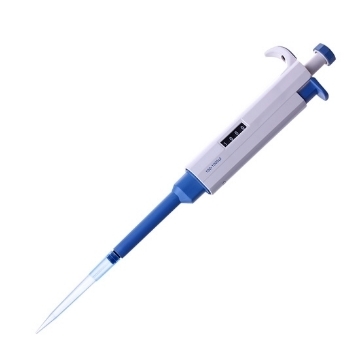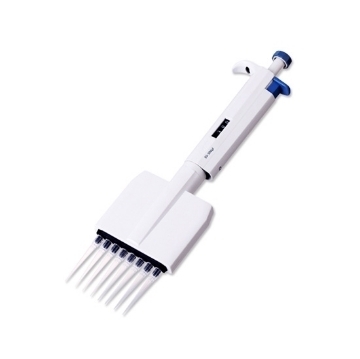A pipette, also called a pipette gun, is a measuring tool used to transfer liquid from an original container to another container within a certain range. It is widely used in biology, chemistry and other fields. Pipettes are widely used in clinical laboratories because of their simple basic structure and ease of use. Its basic structure mainly includes several parts such as display window, capacity adjustment component, piston, O-ring, suction tube and suction head (liquid suction nozzle).
Working principle
The working principle of commonly used pipettes in clinical settings is based on Hooke's Law: within a certain range, the extension of a spring is directly proportional to the force applied, which means that the volume of liquid inside the micropipette is proportional to the spring force inside the micropipette.
There are two physical principles for adding samples using micropipettes: using an air cushion for sample addition and using air-free piston positive displacement for sample addition. These two different principles have specific application ranges for micropipettes.
Types
- According to the working principle, it can be divided into air displacement pipette and forward displacement pipette;
- They can be divided into single-channel pipettes and multi-channel pipettes according to the number of tips that can be installed at the same time;
- Depending on whether the scale is adjustable, they can be divided into fixed pipettes and adjustable pipettes;
- According to the way of adjusting the scale, they can be divided into manual pipettes and electric pipettes;
- According to special uses, they can be divided into fully sterilized pipettes, large-capacity pipettes, bottle-top pipettes, continuous injection pipettes, etc.
Instructions for Use
Select the Appropriate Micropipette:
- When transferring standard solutions (such as water, buffer solutions, diluted salt solutions, and acid-base solutions), use air displacement micropipettes.
- For liquids with high volatility, high viscosity, or a density greater than 2.0g/cm, or for clinical polymerase chain reaction (PCR) applications, use positive displacement micropipettes.
- For example, when transferring 15ul of liquid, it is best to choose a micropipette with a maximum capacity of 20ul; selecting a micropipette with a capacity of 50ul or more may not be as accurate.
Set the Pipetting Volume:
- Adjust the volume control knob of the micropipette to set the desired pipetting volume. When adjusting the volume, turn the scale beyond the set volume and then back to the desired volume to ensure the best accuracy.
Attach the Tips:
- When using a single-channel micropipette, align the nozzle cone of an adjustable micropipette with the tip opening, and gently press down vertically to secure it.
- When using a multi-channel micropipette, align the first row of the micropipette with the first tip opening, insert it at an angle, and gently shake it forward and backward to secure it.
Pipetting:
- Ensure that the micropipette, tips, and the liquid to be transferred are at the same temperature.
- Rinse the tip 1-2 times with the liquid to be transferred, especially for viscous or non-water density liquids.
- When pipetting, insert the tip into the liquid to a depth of 2-3mm below the liquid surface (avoid fully immersing the tip in the solution), slowly and evenly release the plunger, let the liquid be aspirated, wait for 2-3 seconds, and gently touch the tip to the container wall to remove excess liquid from the outer surface of the tip.
Storing the Micropipette:
- After using the micropipette, press down the plunger with your thumb to eject the tip, set the volume to its maximum capacity as indicated, and then hang the micropipette on a dedicated micropipette stand.
- For long-term storage, place the micropipette in a designated box.
Pipetting Methods:
- Forward Pipetting Method: Press the pipetting plunger to the first stop position, then slowly release it back to the original position. Next, press the pipetting plunger to the first stop position to dispense the liquid, pause briefly, and then press it to the second stop position to remove any residual liquid. Finally, slowly release the pipetting plunger.
- Reverse Pipetting Method: Start by pressing the plunger to the second stop position, then slowly release it to the original position. To dispense the desired volume of liquid, press the pipetting plunger to the first stop position, continue to hold it there to remove any remaining liquid, and then discard the tip.
Important Notes:
- When adjusting the micropipette, avoid turning the knob too quickly or exceeding its maximum or minimum range, as this can lead to inaccurate measurements and damage the internal mechanics of the micropipette.
- During tip attachment, repeatedly striking the tip with the micropipette may prevent it from securing properly and can lead to loosening of internal components over time, potentially causing the adjustment knob to jam.
- Do not place the micropipette horizontally or upside down when there is liquid inside the tip to avoid liquid backflow, which can corrode the piston spring.
- When autoclaving the micropipette, first check if your specific micropipette is suitable for high-temperature sterilization before proceeding.
A pipette is a laboratory tool used for accurately measuring and transferring small volumes of liquid. Pipettes come in various types and sizes, and they are essential equipment in scientific research, medical laboratories, and various industries where precise liquid handling is required. sisco offers a variety of pipettes, there's always one that will satisfy you.


